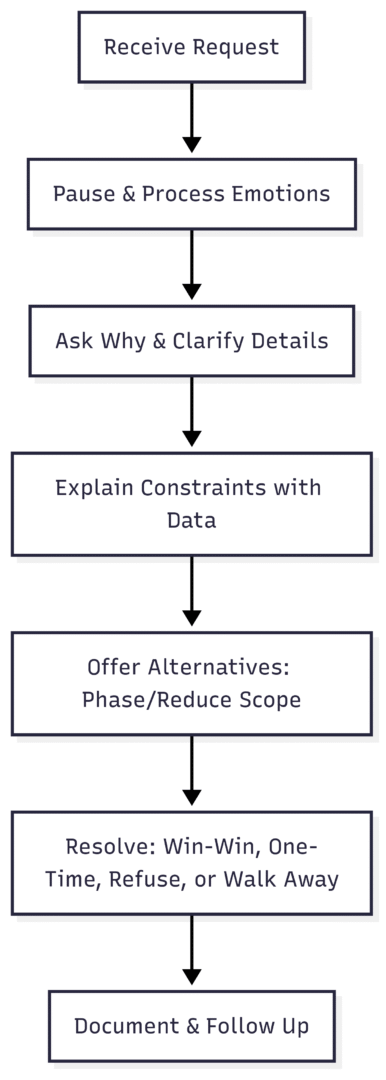Unrealistic Project Requests & How To Handle Them
Unrealistic project requests disrupt workflows, strain resources, and risk failure across industries like photography, marketing, operations, and software development. These demands often stem from misaligned expectations, leading to scope creep, budget overruns, and team burnout. This comprehensive guide explores root causes, warning signs, step-by-step handling methods, optimization strategies, and essential tools to manage them effectively. By addressing these proactively, professionals can foster better collaborations, protect boundaries, and deliver successful outcomes.
Understanding Unrealistic Project Requests
Unrealistic requests manifest as demands that exceed feasible timelines, budgets, or scopes without adjustments. In photography, a client might request a 30-minute shoot combining food, product, and headshot photography for $200, ignoring setup complexities. In software projects, stakeholders may demand feature additions mid-sprint, disregarding microservices boundaries. Marketing teams face rushed campaigns across channels without adequate lead times.
These requests erode trust, inflate costs, and delay deliverables. Research from the Project Management Institute (PMI) indicates 60% of project failures tie to scheduling issues, including inaccurate estimates and procrastination. PricewaterhouseCoopers’ analysis of over 10,000 projects shows only 2.5% complete all on time and budget, with schedule overruns averaging 70% in one-sixth of cases.
Impacts include:
- Financial: Overruns from rushed work or overtime.
- Operational: Reduced quality, leading to rework.
- Human: Burnout, lowering morale and productivity.
Recognizing these early allows redirection toward viable solutions.
Root Causes of Unrealistic Requests
Several factors contribute to these demands, often interconnected.
- Lack of Planning and Estimation: Projects without detailed scopes lead to arbitrary constraints. Underestimation ignores buffers for uncertainties, while overestimation deters clients. PMI notes 26% of failures from inaccurate time estimates.
- Poor Communication: Misunderstandings arise from siloed teams or infrequent updates. Stakeholders unaware of progress assume flexibility, causing discrepancies.
- Desire to Please or External Pressures: Fear of losing clients prompts agreement to unfeasible terms, snowballing issues.
- Competing Interests: Stakeholders prioritize differently—e.g., marketing demands quick launches, operations focus on quality.
- Evolving Demands: Initial briefs change without formal processes, leading to creep.
| Cause | Description | Common Impact |
|---|---|---|
| Lack of Planning | Skipping detailed scopes and estimates | Arbitrary deadlines, resource shortfalls |
| Poor Communication | Infrequent updates or jargon | Misaligned expectations, delays |
| Pressure to Please | Agreeing without review | Overcommitment, burnout |
| Competing Interests | Varied stakeholder priorities | Conflicting directives |
| Evolving Demands | Uncontrolled changes | Scope creep, budget overruns |
Addressing causes requires structured processes from inception.
Signs of Unrealistic Expectations
Detect issues early through these indicators:
- Missed Deadlines: Consistent failures signal underestimated timelines.
- Poor Performance: Rushed work yields errors or low quality.
- Cost Overruns: Expenses exceed budgets due to added demands.
- Scope Creep: Frequent additions without adjustments.
- Team Strain: Burnout from overload.
In photography, a $200/30-minute request ignores lighting setups. In operations, cross-departmental demands exceed capacity.
Step-by-Step Guide to Handling Unrealistic Requests
Manage requests systematically to educate, demonstrate expertise, and resolve.
Step 1: Understand the Request and Why
Pause to process emotions—avoid reactive responses. Ask “why” to uncover needs: Is it pressure from bosses? Use empathy: “I see why this is urgent; let’s explore options.”
Clarify details: Discuss deliverables, outcomes, and motivations. This builds rapport and reveals root problems.
Step 2: Explain Reality and Constraints
Show empathy: Acknowledge goals. Provide context: Use data on budgets, resources, timelines. Be transparent: Highlight risks like quality loss.
In photography, explain setups for food/product/headshots. In software, detail microservices impacts.
Avoid jargon; focus on client benefits.
Step 3: Offer Realistic Alternatives and Resolve
Prioritize: Suggest phasing or core features first. Use contracts: Include clauses for out-of-scope costs.
Strategies:
- Win-Win: Reduce scope for faster delivery.
- One-Time Offer: Exception for key clients, emphasizing rarity.
- Refuse Politely: If unfeasible, suggest alternatives or end professionally.
- Walk Away: If rude or impossible, protect reputation.
Formalize with scope change requests: Analyze impacts on time/cost.

This chart outlines the handling process.
Industry-Specific Examples
Photography and Creative Fields
Requests like quick shoots ignore styling/lighting. Respond educationally: Share processes, ask questions (shot list, mood). Weed bad clients via templates.
Example: For a $200/30-minute request, highlight setups; if standardized, flag as mismatch.
Marketing and Operations
Marketing handles asset/campaign requests; operations manage IT/HR. Use forms for intake, lead times (e.g., 20 days for brochures).
Higher education: Centralize dean requests. Healthcare: Ensure compliance in forms.
Retail: Coordinate multi-channel efforts.
Software and Agencies
Monoliths to microservices: Requests break boundaries. Negotiate estimates; manage creep via charters.
Agencies: Bridge clients/teams with forms.
| Industry | Common Request | Handling Tip |
|---|---|---|
| Photography | Multi-type shoots in short time | Educate on setups; template responses |
| Marketing | Rushed campaigns | Standard lead times; prioritization criteria |
| Operations | Cross-dept needs | RAID logs for risks |
| Software | Feature adds mid-sprint | Negotiation; buffers |
| Agencies | Scope changes | Change control processes |
Optimization Strategies for Project Requests
Streamline workflows to prevent unrealistic demands.
- Communicate Lead Times: Set standards (e.g., 2 days for graphics); use forms to enforce.
- Standardized Submission: Use forms for details; attach data.
- Review and Prioritize: Criteria like alignment/objectives; software for visibility.
- Planning and Strategy: Charters outline goals; collaborate.
- Execution: Track via software; updates.
- Evaluation: Measure KPIs; feedback.
Additional:
- Templates for common requests.
- Status updates.
- Stakeholder feedback.
Essential Tools for Managing Requests
Leverage software for intake, tracking, prioritization. Prices as of 2025:
| Tool | Key Features | Pricing (per user/month, annual) |
|---|---|---|
| Asana | Task tracking, dashboards, integrations | Starter: $10.99; Advanced: $24.99 |
| Monday.com | Custom workflows, automations, reporting | Basic: $9-12; Standard: $12-17; Pro: $28 |
| Trello | Kanban boards, power-ups, attachments | Standard: $5; Premium: $10 |
| Cflow | Workflow automation, forms, AI insights | Joy: $11 (min 10 users); Bliss: $16 (min 20) |
| Workzone | Request forms, lead times, coaching | Starts at $6; ~$24 for full features |
Select based on needs: Cflow for automation; Asana for teams.
Skills for Effective Management
- Negotiation: Balance wants/needs; use data.
- Emotional Intelligence: Empathize, manage stress.
- Scheduling: Tools like Gantt; buffers.
- Risk Management: RAID logs.
- Communication: Clear, frequent.
Training in PMI certifications enhances these.
Conclusion
Unrealistic requests challenge professionals but offer education opportunities. By understanding causes, spotting signs, and applying structured handling, you protect projects and relationships. Optimize with strategies and tools like Asana or Cflow for efficiency. Master these, and turn demands into successes.
Please share this Unrealistic Project Requests & How To Handle Them with your friends and do a comment below about your feedback.
We will meet you on next article.
Until you can read, The Food Photography Fundamentals






